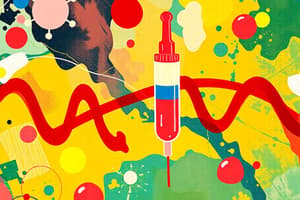Podcast
Questions and Answers
What category of insulin is rapid acting?
What category of insulin is rapid acting?
- Glargine (Lantus)
- Humalog R
- Humalog (correct)
- Humulin N
A continuous glucose monitor (CGM) is a device used for monitoring
A continuous glucose monitor (CGM) is a device used for monitoring
- blood glucose levels through interstitial fluid on a continual basis (correct)
- body temperature on a continual basis
- blood pressure on a continual basis
- heart rate variability on a continual basis
The ADA now recommends HgbA1c less than 7%.
The ADA now recommends HgbA1c less than 7%.
True (A)
What is the primary side effect of oral antidiabetic agents?
What is the primary side effect of oral antidiabetic agents?
Which of the following is NOT a long-term complication of diabetes?
Which of the following is NOT a long-term complication of diabetes?
What is a frequent complication of diabetes that can lead to serious health issues?
What is a frequent complication of diabetes that can lead to serious health issues?
What does DKA stand for?
What does DKA stand for?
What term is often used to describe how much a given food increases the blood glucose level compared with an equivalent amount of glucose?
What term is often used to describe how much a given food increases the blood glucose level compared with an equivalent amount of glucose?
What are the three Ps of diabetes?
What are the three Ps of diabetes?
Gestational diabetes is a type of diabetes that develops during pregnancy.
Gestational diabetes is a type of diabetes that develops during pregnancy.
Flashcards
Type 1 Diabetes
Type 1 Diabetes
A form of diabetes where the body doesn't produce enough insulin because the insulin-producing beta cells in the pancreas are destroyed.
Type 2 Diabetes
Type 2 Diabetes
A form of diabetes where the body doesn't use insulin effectively (insulin resistance) and may not produce enough insulin.
Glycated Hemoglobin (A1C)
Glycated Hemoglobin (A1C)
A measure of average blood sugar control over the past 2-3 months.
Fasting Plasma Glucose (FPG)
Fasting Plasma Glucose (FPG)
Signup and view all the flashcards
Diabetic Ketoacidosis (DKA)
Diabetic Ketoacidosis (DKA)
Signup and view all the flashcards
Insulin
Insulin
Signup and view all the flashcards
Insulin Pump
Insulin Pump
Signup and view all the flashcards
Diabetes
Diabetes
Signup and view all the flashcards
Neuropathy
Neuropathy
Signup and view all the flashcards
Retinopathy
Retinopathy
Signup and view all the flashcards
Nephropathy
Nephropathy
Signup and view all the flashcards
Study Notes
Chapter 46: Assessment and Management of Patients With Diabetes
- This chapter covers the assessment and management of patients with diabetes.
- The outcomes of the chapter include differentiating between types of diabetes, identifying diagnostic and clinical significance of blood glucose test results, describing the relationship between diet, exercise, and medication for people with diabetes, describing management strategies for sick days, outlining major complications of diabetes, and describing self-care behaviors for prevention.
- Key terms include diabetic ketoacidosis (DKA), fasting plasma glucose (FPG), glycated hemoglobin (HbA1c), nephropathy, and neuropathy.
- Retinopathy is a condition that occurs when the small blood vessels that nourish the retina in the eye are damaged.
- Insulin is a hormone secreted by the beta cells of Langerhans of the pancreas, vital for carbohydrate, protein, and fat metabolism. A lack of insulin results in diabetes.
- An insulin pump is a continuous subcutaneous insulin infusion device that delivers insulin continuously.
- Insulin functions as an anabolic or storage hormone. When a person eats, insulin secretion increases, moving glucose from the blood into muscle, liver, and fat cells. In cells, insulin transports and metabolizes glucose for energy, stimulates glucose storage as glycogen, signals the liver to stop releasing glucose, enhances dietary fat storage, accelerates amino acid transport, and inhibits the breakdown of stored glucose, protein, and fat.
- Globally, over 382 million people have diabetes, with 90% having type 2.
- Diabetes prevalence is increasing. A recent study indicated a prevalence of 32.8% in Saudi Arabia in 2025, projected to rise to 40.8% in 2025 and 45.8% by 2030.
- Diabetes is a leading cause of death from heart attack, stroke, and peripheral vascular disease. Hospitalization rates are 2.4 times higher for adults and 5.3 times higher for children with diabetes compared to the general population. The economic cost is rising due to increasing healthcare costs and an aging population.
- Diabetes classifications include type 1, type 2, latent autoimmune diabetes of adults (LADA), and gestational diabetes.
- Type 1 diabetes typically starts at a younger age and results from beta cell destruction.
- Type 2 diabetes typically starts later and involves insulin resistance and impaired insulin secretion.
- Important risk factors for the development of diabetes include age, high-density lipoprotein (HDL) and triglyceride levels, history of gestational diabetes, hypertension, family history, obesity, and race/ethnicity.
- Clinical characteristics that manifest the presence of diabetes are often related to fluctuating blood sugar levels.
- Common symptoms include excessive urination (polyuria), excessive thirst (polydipsia), and increased hunger (polyphagia). Fatigue, weakness, vision changes, tingling or numbness, dry skin, slow-to-heal skin lesions, and recurrent infections are also potential symptoms. The onset of type 1 diabetes may also be associated with weight loss, or nausea, vomiting, or abdominal pains.
Assessment of the Patient with Diabetes
- History of Symptoms (hyperglycemia, hypoglycemia)
- Results of blood glucose monitoring (frequency, timing, severity, and resolution)
- Status, symptoms, and management of chronic complications (eye, kidney, nerve, genitourinary, bladder, GI, cardiac, peripheral vascular, and foot)
- Adherence to dietary, exercise, and pharmacological treatment plans (insulin or oral agents).
- Tobacco, alcohol, and other medication use.
- Lifestyle and psychosocial, and economic factors impacting treatment
Physical Examination
- Blood pressure (sitting and standing)
- Body mass index
- Funduscopic examination
- Foot examination (lesions, signs of infection, pulses)
- Skin examination (lesions, injection sites)
- Neurologic examination (vibratory and sensory, deep tendon reflexes)
- Oral examination
Diagnostic Findings
- HbA1c > 6.5
- Fasting Plasma Glucose (FPG) ≥ 126 mg/dL (7.0 mmol/L)
- Casual glucose exceeding 200 mg/dL
- Two-hour post-load glucose ≥ 200 mg/dL (11.1 mmol/L) during an oral glucose tolerance test.
Medical Management of Diabetes
- Main goal is to normalize insulin activity and blood glucose levels to prevent complications. ADA recommends HgbA1c < 7%. Five components: nutritional therapy, exercise, monitoring, pharmacologic therapy, and education.
Diabetes Team
- A team-based approach is emphasized involving various healthcare professionals like Diabetes Consultant, Clinical Nurse Specialist, Diabetes Dietitian, Psychologist, Insulin Pump Tech, Podiatry Consultant, Clinical Pharmacist, and Certified Diabetes Educator, working together to support the patient.
Dietary Management Goals
- Control of total caloric intake to achieve or maintain a reasonable body weight.
- Control of blood glucose levels.
- Normalization of lipids and blood pressure to prevent heart disease.
Role of the Nurse
- Knowledge of dietary management
- Communication with dieticians and specialists.
- Reinforce patient understanding
- Support dietary and lifestyle changes.
Meal planning
- Consideration of food preferences, lifestyle, eating times, and cultural/ethnic background.
- Review of dietary history, and need for weight loss, gain, or maintenance.
- Caloric requirements and distribution (emphasizing whole grains.)
- Carbohydrate intake (50-60%) and whole-grain emphasis.
- Fat (30%, limit saturated fat, <300mg cholesterol.)
- Non-animal protein, and increased fiber intake.
Glycemic Index (GI)
- Goal of diet therapy is to avoid rapid increases in blood sugar.
- Glycemic index describes how much a food increases blood glucose compared to glucose.
- Guidelines can include combining starchy foods with protein/fat to slow absorption, choosing whole fruits over juices (due to fiber), and combining foods with sugar with slower-digesting foods.
Other Dietary Concerns
- Alcohol
- Nutritive and non-nutritive sweeteners
- Misleading food labels
Exercise
- Lowers blood sugar.
- Aids in weight loss, stress relief, and well-being.
- Lowers cardiovascular risk. Exercise modifications may be required for those using insulin.
Exercise Precautions
- Exercise elevates blood sugar levels; insulin must be adjusted.
- Glucose normally decreases with exercise; patients need to eat 15-gram carbohydrates before moderate exercise to prevent hypoglycemia.
- Potential for post-exercise hypoglycemia; monitor closely, refer to resources.
- Gerontologic considerations (older patient adaptations).
Pharmacologic Therapy
- Insulin therapy is often required. The type and timing of insulin are adjusted based on blood glucose levels and activity.
- Categories of insulin, their onset, peak, and duration are important to consider.
- Other oral antidiabetic agents may be used to help regulate blood sugar.
Insulin Regimen
- Varies from 1 to 4 injections per day.
- Combination of short-acting and long-acting insulin is common.
- Conventional vs. Intensive approaches to regimens (simplification vs. flexibility).
Complications of Insulin Therapy
- Local or systemic allergic reactions
- Insulin lipodystrophy (fat accumulation buildup)
- Resistance to injected insulin
- Morning hyperglycemia
Methods of Insulin Delivery
- Traditional subcutaneous injections
- Insulin pens
- Jet injectors
- Insulin pumps (basal rate, meal doses)
Educating Patients in Insulin Self-Management
- Understand insulin use and actions.
- Recognize symptoms of hypoglycemia and hyperglycemia, including required actions.
- Techniques for blood glucose monitoring.
- Self-injection of insulin.
- Insulin pump use.
Oral Antidiabetic Agents
- Used for patients with type 2 diabetes requiring more than diet and exercise.
- Combinations of oral drugs may be used.
- Major side effect: hypoglycemia.
- Nursing interventions (monitoring blood glucose and educating).
Sites of Action of Oral Antidiabetic Agents
- Shows the mechanism of action for these agents.
Pancreatic Islet Transplantation
- Process of isolating the gland and transplanting islets of the pancreas to help regulate blood sugar.
Monitoring Glucose Levels and Ketones
- Blood glucose monitoring (finger pick, continuous glucose monitors (CGM) and Flash glucose monitoring).
- Importance of glycated hemoglobin (HbA1c)
- Use of CGM and flash glucose monitors to avoid finger pricks.
Diabetes Foot Problems
- High risk for foot problems and infections.
- Contributing factors (neuropathy, peripheral vascular disease, reduced immune response to infections, and injury)
- Diabetic foot assessment includes exam of peripheral pulses, sensation, and visual acuity.
- Important foot care prevention and management tips.
Acute Complications
- Hypoglycemia (low blood glucose)
- Diabetic ketoacidosis (DKA)
- Hyperglycemic hyperosmolar syndrome (HHS)
Long-Term Complications
- Macrovascular (accelerated atherosclerosis leading to coronary and cerebrovascular disease, peripheral vascular disease)
- Microvascular (diabetic retinopathy, nephropathy).
- Neuropathies (peripheral, autonomic, hypoglycemic unawareness, sexual dysfunction).
- Foot and leg problems (amputations).
Studying That Suits You
Use AI to generate personalized quizzes and flashcards to suit your learning preferences.



